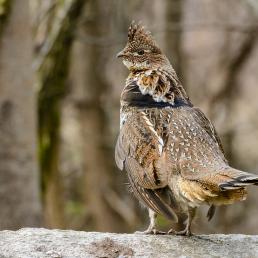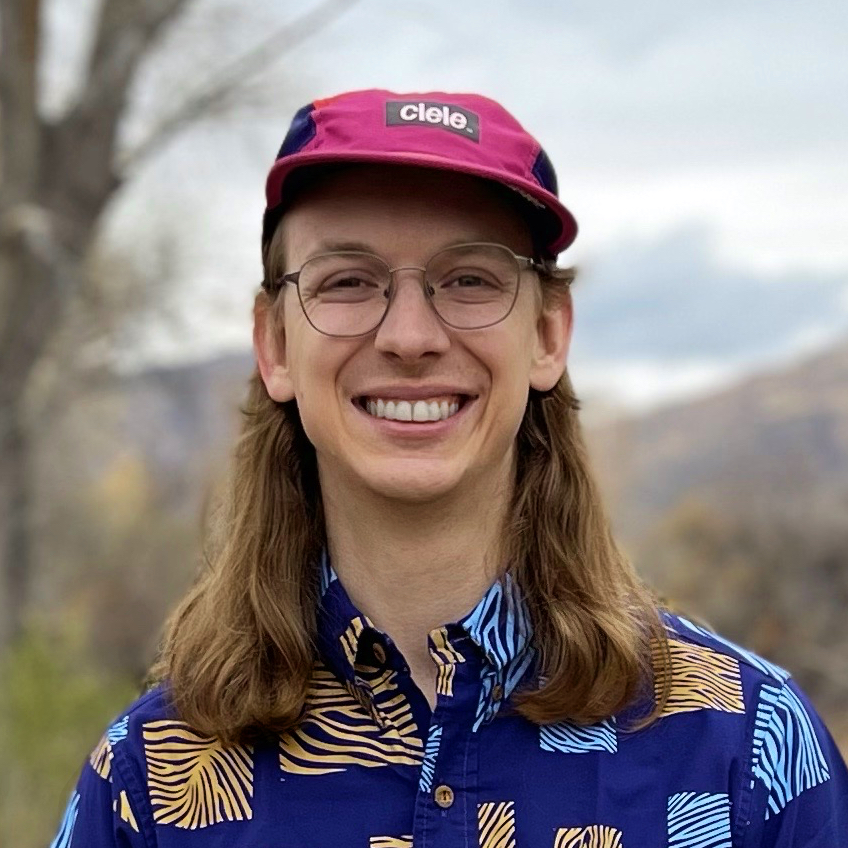

Join BirdNote tomorrow, November 30th!
Illustrator David Sibley and actor H. Jon Benjamin will face off in the bird illustration battle of the century during BirdNote's Year-end Celebration and Auction!
Poet Craig Santos Perez grew up on the island of Guam, and later moved to Hawai‘i where his children were born. Both are places that once flourished with unique and diverse bird life, but because of invasive species and climate change, have seen so much loss and extinction. In this episode, he shares poetry that explores his relationship with lost and endangered wildlife and that reflects on the future his daughter will inherit.
BirdNote®
Craig Santos Perez and the Last Safe Habitat
Written by Mark Bramhill
Mark Bramhill: This is BirdNote.
When poet Craig Santos Perez was growing up, his relationship with birds was somewhat abstract. Craig is Chamorro and grew up on the island of Guam; by the time of his childhood in the ’80s and ’90s...
Craig Santos Perez: Most of our native birds had either gone extinct or were taken into captivity by zookeepers to keep them safe from the invasive brown tree snake, which had come to Guam a few decades earlier and colonized the entire island and taken over the ecology.
And so sadly, growing up, when I would go into the jungle, into the forest, it was a very silent place. I didn't hear any of the native birds. So early memories of the birds, you know, it's basically learning about them in school. Learn their Latin, English, and Chamorro names for them, which is our native language. We would learn about their characteristics, their feather colors, their patterns. And we would even do some projects in school where we would build a fake nest or color in pictures of the birds. And it was kind of, in a memorial kind of way because they were either no longer wild or no longer even in existence.
Mark Bramhill: Craig’s elementary school mascot was actually the ko‘ko‘, the fast-running Guam Rail that was extinct in the wild. But it was a different bird that Craig loved most:
Craig Santos Perez: My favorite was probably the Micronesian Kingfisher, which in Guam we call a sihek, and I kind of fell in love with this bird, mainly for its colors — very bright, like orange and blue feathers. And a cute looking bird. I even have a picture of one, actually, on my desk.
Mark Bramhill: The Micronesian Kingfisher, also known as the Guam Kingfisher, has been extinct in the wild since about 1988. Craig never saw one while he lived on Guam.
Craig Santos Perez: My family migrated to California when I was 15 years old. So I finished high school in Northern California and then traveled to Southern California to go to college. And a student group sponsored a visit to the San Diego Zoo, so I joined, you know, mainly to just meet new people, and I wasn't prepared to actually go to the zoo and to see their bird section.
I saw, in a large cage, perched on a branch, for the first time in my life: a living sihek.
For a moment, I questioned whether what I saw was real or if it was a ghost. I looked at the placard on the front of the cage: “Micronesian Kingfisher. The rarest species in San Diego Zoo Global’s avian collection.”
Hafa adai, I whispered, our traditional Chamoru greeting. While the other students must have thought I was strange, I couldn’t help but talk to the bird, share my name, my clan name, my village. Guahu si Craig Santos Perez, familian Gollo, ginen Mongmong. But I live in California now, just like you.
I just had a very profound moment with this bird who was far from home like me.
Mark Bramhill: Since that visit, Craig has spent a lot of time researching the kingfisher, and has written a series of poems about the bird. Here is one part of that series:
Craig Santos Perez:
ginen the micronesian kingfisher [i sihek]
[our] nightmare : no
birdsong—
the jungle was riven emptied
of [i sihek] bright blue green turquoise red gold
feathers—everywhere : brown
tree snakes avian
silence—
the snakes entered
without words when [we] saw them it was too late—
they were at [our] doors sliding along
the passages of [i sihek]
empire—then
the zookeepers came—
called it species survival plan—captured [i sihek] and transferred
the last
twenty-nine micronesian kingfishers
to zoos for captive breeding [1988]—they repeated [i sihek]
and repeated :
"if it weren't for us
your birds [i sihek]
would be gone
forever"
what does not change /
last wild seen—
[Music fades, sihek calls, transition…]
Mark Bramhill: Later in his life, Craig moved to Hawai‘i and lived there for twelve years. And he saw so many parallels between Hawai‘i and Guam:
Craig Santos Perez: You know, not only in terms of kind of colonial and military history, but also, of course, the environmental history. Hawai‘i struggles with invasive species as well. Just like Guam, many of its native birds are either endangered or extinct.
Mark Bramhill: Hawai‘i has the unfortunate distinction of being the “extinction capital of the world,” where two-thirds of their native bird species have gone extinct. And, beyond that being a heart-wrenching fact, it also was complicated for Craig as a dad.
Craig Santos Perez: My eldest daughter really loves birds. And, you know, she was born and raised in Hawai‘i. So I wanted to write a poem kind of bringing together my concerns as a father, as an environmentalist.
For me, poetry has always been a space of catharsis and healing, and a kind of site where I can reckon with a lot of the devastations of the world around us, whether it's related to colonialism and my home island, or related to climate change and bird extinction.
And so I tried to come to the page with an openness and vulnerability, and a willingness to just feel all the feelings, and to find the words that will kind of help me to just articulate those emotions, and express them in a way that gives me, you know, a feeling of hope, but also, of course, of memorial and kind of a way to honor and to eulogize what we've lost.
Mark Bramhill: Here is the poem that came from that:
Craig Santos Perez:
The Last Safe Habitat
I don’t want our daughter to know
that Hawaiʻi is the bird extinction capital
of the world. I don’t want her to walk
around the island feeling haunted
by tree roots buried under concrete.
I don’t want her to fear the invasive
predators who slither, pounce,
bite, swallow, disease, and multiply.
I don’t want her to see the paintings
and photographs of birds she’ll never
witness in the wild. I don’t want her to
imagine their bones in dark museum
drawers. I don’t want her to hear
birdsong recordings on the internet.
I don’t want her to memorize and recite
the names of 77 lost species and subspecies.
I don’t want her to draw a timeline
with the years each was ‘first collected’
and ‘last sighted’. I don’t want her to learn
about the ʻŌʻō, who was observed atop
a flowering ‘Ōhiʻa tree, calling for a mate,
day after day, season after season.
He didn’t know he was the last of his kind,
or maybe he did, and that’s why, one day,
he disappeared, forever, into a nest
of avian silence. I don’t want our daughter
to calculate how many miles of fencing
is needed to protect the endangered birds
that remain. I don’t want her to realize
the most serious causes of extinction
can’t be fenced out. I want to convince
her that extinction is not the end. I want
to convince her that extinction is just
a migration to the last safe habitat
on earth. I want to convince her
that our winged relatives have arrived
safely to their destination: a wondrous
island with a climate we can never
change, and a rainforest fertile
with seeds and song.
Craig Santos Perez: I remember writing this poem and — you can probably hear in my voice — I became very emotional while writing it. Just thinking about the island and the future that my daughter will inherit. And of course most children, you know, they have a very beautiful and kind of wondrous sense of awe to the natural world, and especially towards animals. And I wanted her to hold on to that before she has to kind of reckon with the facts of the world we live in today.
And so for me, this is kind of a poem about a father who doesn't want his daughter to learn the truth about the world just yet.
Mark Bramhill: Craig’s daughter is still young, and hasn’t heard the poem. But he hopes that, for her and for others, it might also bring a sense of hope and possibility.
Craig Santos Perez: Having this kind of fantasy idea of this last safe habitat, using that wondrous magical space to inspire activism and conservation in the present, knowing that we can never create that magical space, but we can at least kind of return to the beauty of the ecology that once was.
Maybe if she can imagine such a place, maybe her generation or future generations can actually create a planet that is safe for all species.
Mark Bramhill: Many species, like the Kauai ‘O‘o, we can never bring back. But for others, there is a small chance. Since Craig’s encounter with the kingfisher at the San Diego Zoo, captive breeding programs have had some limited success with the kingfishers. There are about 150 alive today — enough to keep the species around, though not to release them into the wild. But the breeding program for Craig's elementary school mascot, the ko‘ko‘ or Guam Rail, has been much more successful.
Craig Santos Perez: The ko‘ko‘ is now the second bird in history to recover from being declared extinct in the wild. Many of them have been released onto neighboring islands that are free of the brown tree snakes. There are several hundred of those now released back into the wild. And so that's, you know, very hopeful news. Still an endangered bird. Obviously the population is still very vulnerable. But most zookeepers consider them to be self-sustaining at this point, so that's really exciting.
Mark Bramhill: You can hear lots more poetry about birds, as well as see photos of the sihek and ko‘ko‘ on our website, BirdNote dot org. I’m Mark Bramhill.
###
Producer: Mark Bramhill
Managing Editor: Jazzi Johnson
Managing Producer: Conor Gearin
Content Director: Jonese Franklin
Bird sounds provided by The Macaulay Library of Natural Sounds at the Cornell Lab of Ornithology, Ithaca, New York. Guam Kingfisher ML5431, ML5453, and ML5435 recorded by Doug Pratt; Kauai ’O’o ML56465 recorded by Thane Pratt; Kauai ’O’o ML228099 recorded by Jim Jacobi; and Guam Rail ML5451 recorded by Doug Pratt.
BirdNote’s theme was composed and played by Nancy Rumbel and John Kessler.
© 2024 BirdNote May 2024
Narrator: Mark Bramhill
ID# PerezC-01-2024-05-01 PerezC-01
Reference:
https://www.fws.gov/press-release/2022-08/experimental-population-sihek…
https://www.audubon.org/news/the-guam-kingfisher-could-soon-return-wild…



